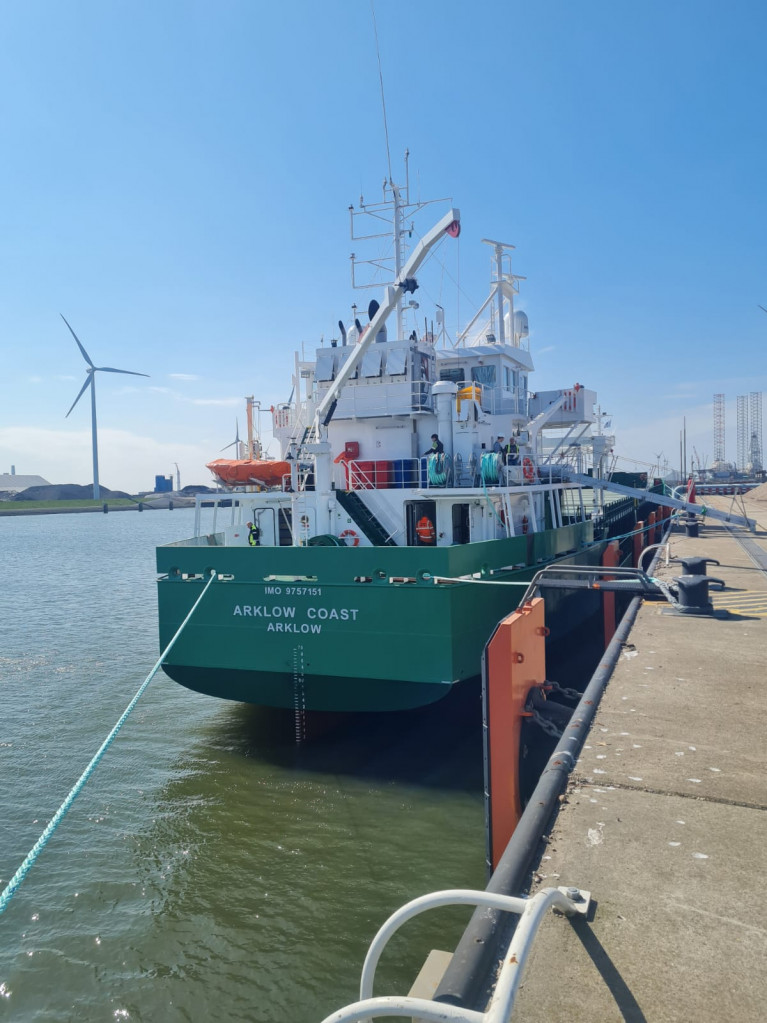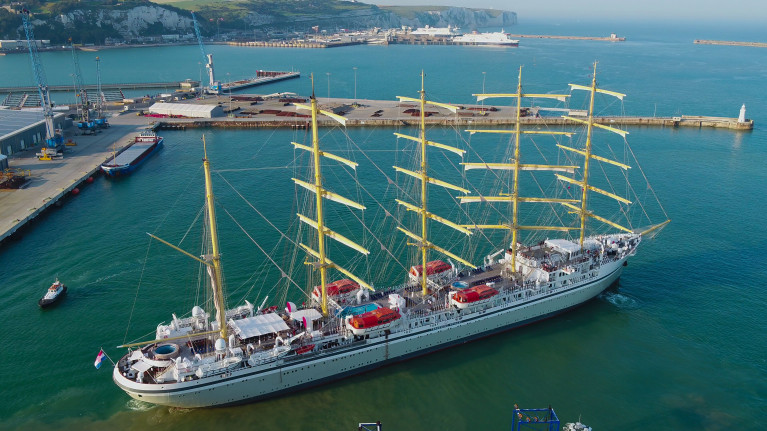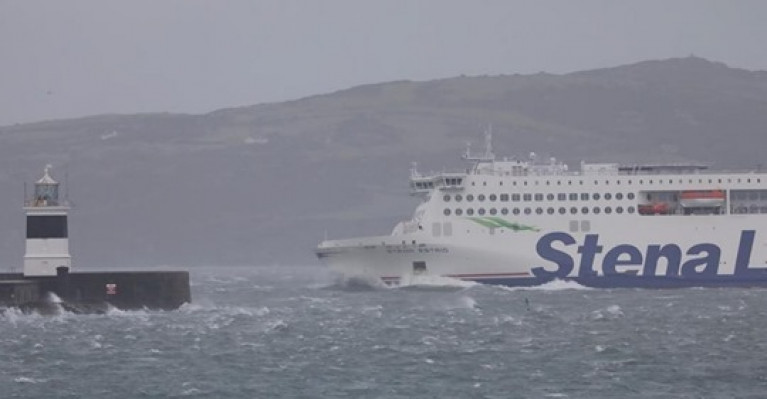Displaying items by tag: Maiden Voyage
Arklow Ranger Makes Maiden Voyage Across North Sea to Norwegian Fjord Port Within the Arctic Circle
The newest Irish flagged merchant ship, Arklow Ranger has made its maiden voyage from The Netherlands to Norway as the newbuild dry-cargo ship arrived this afternoon into the Arctic Circle, writes Jehan Ashmore.
Arklow Ranger departed the Dutch north-east port of Eemshaven having departed last Thursday, 11 January, the day shipbuilder, Royal Bodewes officially delivered the newbuild to Arklow Shipping Ltd. Also that day the newbuild began the maiden voyage, firstly heading through the Wadden Sea and then into the North Sea.
On the Sunday, Afloat continued to track the newbuild when offshore of the Nordic nation’s coast. The inaugural passage was concluded after navigating the 11 nautical mile Glomfjorden to the fjord’s namesake port of Glomfjord with the 105m merchant ship berthing today at around 1500hrs.
Arklow Ranger, is the fourth Eco-Trader 6,800dwat / R class multipurpose newbuild of seven on order from ASL to the Dutch shipbuilders based in Hoogezand, near Groningen, which conducted sea trails in the North Sea based out of Eemshaven.
Currently berthed in the Norwegian port is ASL fleetmate, Arklow Field and their Dutch flagged Arklow Glen.
In addition is a Norwegian based rival, Wilson AS of Bergen, whose cargo ship Wilson Dieppe is berthed ahead of the Arklow trio at the fjord port located in Nordland, a county mid-way located along the country’s rugged and extensive coastline.
The second of seven newbuild cargo ships for Arklow Shipping has been delivered from Dutch shipbuilder Royal Bodewes to the Irish shipowner, writes Jehan Ashmore.
Arklow Rally of the Eco-Trader 6,800 dwat class follows the leadship Arklow Racer which was delivered in February.
The newbuilds were built at Bodewes shipyard in Hoogezand located to the east of Groningen.
The handover of Arklow Rally took place on Monday and the addition of the dry-bulk vessel is part of a continued progression of modern tonnage. At this stage the green-hulled fleet now totals 55 cargo ships.
On Monday evening the newbuild departed on its maiden commercial voyage. This involved a passage across the North Sea to Teesport in north-east England, to where Afloat tracked the arrival of the Irish-flagged newbuild this morning.
Sea trials of the 104m general cargoship had previously taken place in the North Sea with the newbuild based out of Emshaven. The port on the Ems Estuary is also where the Dutch-German border is located.
The first ship operated by Dutch sail cargo company Ecoclipper, De Tukker has set sail on its maiden commercial liner voyage in which Afloat tracked the vessel in the English Channel recently when offshore of Guernsey.
De Tukker with five crew and equally the same number of trainees had departed Amsterdam carrying chocolate on the cargoship that is currently in the Bay of Biscay. The ship is handling well and is heading for Porto, Portugal where ketch is expected to arrive around May 13th and take on a cargo of wine and olive oil.
This is the first voyage on a sailing schedule which will see the sail-cargoship operate on a regular route network as Afloat reported across North and West Europe
Following a refit and sea trials, De Tukker, which was built in 1912 and seen life as a coastal trader and sail training vessel, is now propelled again by over 300 square metres of sail.
De Tukker is able to carry about 70 cubic metres, or an equivalent of 50-70 tons, of cargo and has accommodation for up to 12 trainees or travellers.
The first cargo onboard is chocolate produced by Dutch chocolate maker "Chocolatemakers" and destined for European distribution by sail cargo brokers “New Dawn Traders”.
The cacao used in the chocolate’s production process was shipped from the Dominican Republic by fellow sail cargo vessel Tres Hombres and so will reach consumers with a minimum of harmful emissions produced in its transport.
De Tukker’s currently scheduled destinations are Porto, Noirmoutier, Saint Nazaire, Penzance, Torquay and London, however, depending on the needs of exporters and consumers EcoClipper is open to adding additional ports to the route.
Jorne Langelaan, EcoClipper founder and CEO, has expressed his excitement that De Tukker is now sailing again. “After a year-long period of expert refitting by our own refit crew and the crew of the Talsma shipyard, it was with the greatest pleasure that I watched De Tukker sail off towards the horizon. This is the next step in returning to large scale transport by sailing vessel at sea.”
There is still cargo space available for exporters who want to take advantage of this new shipping option in Northern and Western Europe. Visit the EcoClipper website here for more information.
The voyage is being covered by De Tukker’s Captain, Paul Pélaprat, on EcoClipper’s Instagram page @ecoclipper
Arklow Coast Completes Commercial Maiden Voyage from 'Sluice' Port Via the Scheldt to Spain
Arklow Coast of 2,999 gross tonnage, is a brand new C-class coaster which began a commercial maiden voyage from the Netherlands that was completed in Spain at the weekend, writes Jehan Ashmore.
The newbuild is the 8th so far in service from the C-class series of 10 single-hold general cargoships ordered by Arklow Shipping Ltd to Dutch shipyard Ferus Smit at Westerbroek which Afloat reported.
Subsequently, the 87m Arklow Coast was tracked to Eemshaven from where shipyard sea-trails had taken place in the southern North Sea, before the 5,045dwt cargoship was handed over to ASL.
When Afloat was tracking the English Channel last Thursday, the Arklow Coast was noted heading westbound on the busy shipping lanes while offshore of Brighton.
Arklow Shipping has confirmed to Afloat that this was indeed the maiden voyage of the Arklow Coast, a name used for the first time by the Co. Wicklow shipowners. which uses the 1A Ice-class newbuild to transport bulk commodities in European waters. This involves the single-hold with a capacity of 200,000ft3.
The maiden voyage of Arklow Coast had set off from Sluiskil, in the Dutch province of Zeeland and where the inland port is located south of Terneuzen close to the Belgium border.
The departure from Sluiskil, a village which translates to the 'exit canal of the sluice', required transitting the Ghent-Terneuzen Canal leading into the Scheldt. From the river is where the coaster proceeded into the Scheldt estuary to reach the open waters of the North Sea.
A single 1,740Kw Mak engine powered the short-sea trader cross the Bay of Biscay with the maiden voyage completed on Saturday. This took place when the cargoship arrived in Avilés, a port in northern Spain located in the principality of Asturias.
World's Largest Cruise Tallship, Golden Horizon Calls to Port of Dover For Inaugural Call
The World's largest square-rigged sailing vessel, the brand new cruise tallship Golden Horizon in mid-July sailed into the Port of Dover; the ship's departure port for four new UK voyages throughout this month.
The Golden Horizon, a near replica of the 1913 built tallship France II, operates for Tradewind Voyages which deployed their newbuild to the cruise and ferryport with the lastest departure from the English south-east port having taken place last week.
Sonia Limbrick, Head of Cruise at the Port of Dover said: “We offer a very warm welcome to the beautiful Golden Horizon here in Dover today (15 July), what an extraordinary ship she is! I hope our local community makes the most of the rare opportunity to see her before she departs for four cruises throughout July.
I’m really pleased to see the cruise season back in full swing again; it’s exciting to see another new cruise line at the Port, both for the first time in Dover and as she prepares to embark on her first ever voyages.”
The call marks the third passenger cruise call in just under three weeks to depart from the Port of Dover since its cruise season re-launch on 26th June. The Port’s cruise team has been working hard on COVID safe measures to help protect visiting cruise lines, their crew and passengers. For further information visit here.
After the inaugural call, Golden Horizon at this stage will make a final departure from the Kent port scheduled to take place on 31st July.
The newest Stena Line ferry is expected to begin sailing the Dublin to Holyhead route on the Irish Sea today.
The 215m (705ft) Stena Estrid, writes Independent.ie, is described as "one of the most advanced vessels in operation", with space to carry 120 cars and 1,000 passengers.
The ship's official maiden voyage, a 8.55am sailing from Holyhead to Dublin, has been delayed due to adverse weather coinciding with Storm Brendan, but a 2.50pm departure from Dublin remains on schedule as we publish.
For more click the newspaper here in addition to Welsh coverage from the NorthWalesLive.
In an update, Afloat adds that the corresponding sailing from the Irish capital has been delayed this afternoon. According to the Stena Line website, the 'new generation' ropax ferry has been delayed approximately by an hour due adverse weather conditions.
#FerryNews - Completing a maiden high-speed craft (HSC) crossing on Irish Ferries Dublin-Holyhead route this morning is Dublin Swift, replacing a smaller craft that has served for almost two decades, writes Jehan Ashmore.
The Dublin Swift docked in Holyhead this morning just after 11.00.
The newcomer takes over from HSC Jonathan Swift which has operated since 1999 on the core Irish Sea route. The car-carrying catamaran becomes the largest fast-ferry on the Irish Sea and has entered service in the shoulder season in advance of the busy high-season months on the Ireland-Wales link.
Dublin Swift operates at 35 knots to maintain the same frequency of sailings with twice daily return crossings likewise to the replaced Jonathan Swift. ICG sold the fastferry to Spanish operators to serve a career in the Meditteranean linking the Balearics.
Prior to introduction, Dublin Swift underwent a refurbishment programme in Belfast following a charter overseas, so to bring the HSC up to Irish Ferries standards for 820 passengers and space for 200 vehicles. Onboard facilities are located on one deck, compared to the double deck arrangment on Jonathan Swift.
The facilities of Dublin Swift include a dedicated TV Snug, cafeteria, self-service restaurant and games area.
Passengers have a selection of spacious seating accommodation in the standard cabin, or plush reclining seats with views to sea, in-seat recharging points and complementary refreshments in the Club Class Lounge. This area of the fastferry is positioned at the bow. Free Wi-Fi is offered throughout.
The HSC brings increased capacity on the core Irish Sea route also operated by flagship Ulysses and ropax Epsilon.
The 8,403 gross tonnage Dublin Swift, (formerly Westpac Express) was in 2016 acquired by ICG, parent company of Irish Ferries for $13.25 million. Built in 2001 by Austal Ships Pty to their in-house 101m Auto-Express design. The yard in Fremantle, western Australia is also where Jonathan Swift was custom built for ICG.
Dublin Swift is also the only fast ferry operating between Ireland and Britain, though the Isle of Man is served by the Steam-Packet's fastferry Manannan on seasonal routes including the Dublin link.
#DublinPort - The brand new Delphine made a maiden call to Dublin Port, the giant ship is a sister of leadship Celine, claimed to be the world’s largest short-sea ro-ro freightship, writes Jehan Ashmore.
The Celine of 74,000 gross tonnage is now equally partnered with Delphine's debut. The newbuild arrived from Zeebrugge, Belgium but firstly anchored in Dublin Bay to wait for Celine's departure from the port. This took place last Thursday evening.
The sisters operated by CLdN Ro Ro SA /Cobelfret Ferries serve the Rotterdam-Zeebrugge-Dublin route which is also connected to a UK port.
Delphine has an impressive 8,000 freight lane metres and can handle 600 freight units. The South Korean built Delphine boosts capacity to Celine and together provide Irish exporters with greater flexibility by trading with markets in continental Europe, particularly against the backdrop of post-Brexit.
Luxembourg based CLdN also offers connections from the European mainland, Scandinavia and Iberia.
Delphine's inaugural call to the Irish port's Alexandra Basin is from where the 234m ro-ro docked at the custom-built ro-ro ramp linkspan.
On the occasion of Celine's first call in October last year, the ship instead docked in Alexandra Basin (East). The change to the new ro-ro linkspan took place the next month allowing smaller fleetmates also serving to continue to use the adjacent basin facility.
The Maltese flagged Delphine has a beam of 35m and the cargo decks are all accessed through an aft vehicle loading/unloading ramp. Cargoes using the ship's ro-ro ramp includes unaccompanied trailers, tank containers, project cargo, new cars.
In addition accommodation is available for 12 driver accompanied units.
World's Largest Ro-Ro Freight Ferry Completes Maiden Voyage from Continental Europe to Dublin Port
#WorldLargest - An historic milestone in Dublin Port took place late last night as Celine, the world’s largest short-sea ro-ro freight ferry completed a commercial maiden voyage from mainland continental Europe, writes Jehan Ashmore.
On arrival from Zeebrugge, Belgium, a pair of tugs assisted the giant Celine to dock in Dublin Port just after 23.00hrs.
At 234m long the sheer length of the new ship was demonstrated in that Alexandra Basin East’s Ocean Pier is 242m. The measurement of the ship does not take into account the length of the ship's stern loading ramps when lowered into position at the berth's linkspan which itself is part of the overall pier length. As such Celine's bow has extended beyond the pier out into the port’s main internal shipping channel, unlike fleetmate Valentine of just 162m (see photo related story).
At 74,000 gross tonnage, Celine is easily the biggest capacity ro-ro freight ferry to Dublin Port having sailed on the Rotterdam-Zeebrugge to the Irish capital with up to 8,000 freight lane meters. The next largest regular ro-ro ship using Dublin is Irish Ferries cruiseferry giant Ulysses of 50,000 gross tonnage and around half the freight unit capacity.
Ships such as Celine serving direct Ireland-continent services have raised concerns with landbridge routes via the UK, notably Holyhead, see story posted on Afloat yesterday.
Celine can handle 600 freight units which will provide Irish exporters with additional capacity and greater flexibility by trading with markets in continental Europe, particularly in post-Brexit. The range of cargoes includes unaccompanied trailers, tank containers, project cargo, new cars and a capacity for 12 driver accompanied units. The ro-ro ship however will also include a North Sea link from Belgium to the UK.
Landlocked based operators, CLdN Ro Ro S.A. of Luxembourg had placed the order for Celine to South Korean yard of Hyundai Heavy Industries at their Mipo Dockyard in Ulsan. Celine also has green credentials in that the newbuild is 'LPG ready' which brings greater flexibility to operations.
The debut of Celine also marks a significant era for CLdN /Cobelfret Ferries as the newbuild is the first of a major intensive fleet expansion programme with a sister due for delivery later this year. The programme is for 12 newbuilds, so far six have been completed. They will join an extensive short-sea network across northern Europe.
Asides the ports mentioned that Celine is serving, other members of the 24 strong ro-ro fleet also operate other routes calling to Gothenburg, Esbjerg, Hirtshals, Santander and Porto.

































































